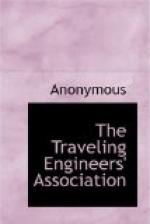A. This may be caused by the feed valve being improperly adjusted, sticking in open position or leakage of main reservoir air past the valve to the feed valve pipe and governor top.
=Westinghouse 9-1/2 or 11-inch compressor=
42. Q. What is the duty of the air compressor?
A. To furnish the compressed air used in the operation of the brakes, and all other air operated appliances on both locomotive and cars.
43. Q. Explain the operation of the steam end of the compressor.
A. When steam is turned on at the boiler it flows through the steam pipe and governor, entering the compressor at the steam enlet, then through the steam passage “a” to the reversing valve chamber “C” also to the main valve chamber “A” between the differential pistons 77 and 79. The area of the piston at the right being greater than the one at the left, the main valve is moved to the right, (See Fig. 2) admitting steam to port “b” which leads to the lower end of the steam cylinder; steam is now free to flow under the main piston, forcing it upward. When the piston has almost completed its upward stroke, the reversing plate 69 on top of the piston 65 engages a shoulder on the reversing rod 71, moving the rod and reversing valve 72 upward (See Fig. 3). The upward movement of the reversing valve closes the ports “f” and “h” and opens port “g”; thus permitting steam to enter the chamber at the right of the large piston 77, balancing the pressure on this piston, and the pressure acting on the right side of the small piston 79—the chamber at the left being open to the exhaust—will force the main valve to the left.
[Illustration: Diagrammatic View, Up Stroke Fig. 2.]
When the main valve moves to the left, steam is admitted through port “c” to the upper end of the cylinder on top of the piston 65, forcing it downward. At the same time the lower end of the cylinder is connected through exhaust cavity “b” of the main valve to the exhaust port “d”, allowing the steam below the piston to escape to the atmosphere.
44. Q. When the piston has about completed its downward stroke, what takes place?
A. The reversing plate 69 engages the button “k” on the end of the reversing rod 71 pulling the rod and the reversing valve down. This movement of the reversing valve closes port “g” and the cavity in the face of the valve connects ports “f” and “h”, which allows the steam in chamber “D” at the right of the large differential piston to escape to the exhaust, thus allowing the main valve to move to the right, exhausting the steam from the top end of the cylinder, and at the same time admitting steam to the lower end, causing an upward stroke of the piston.
45. Q. Explain the operation of the air end of the compressor.
A. The movement of the steam piston 65 is imparted to the air piston 66 by means of the piston rod. When the air piston moves up, a partial vacuum is formed below it, and air from the atmosphere will enter through passage “F” thence through passage “n” to the under side of receiving valve 86b (see Fig. 2), lifting this valve from its seat, and will fill the cylinder with air at about atmosphere pressure.




